What’s a Droplet?#
Taken literally, a droplet is a small drop of liquid. Thanks to DigitalOcean, it’s now also a clever joke about cloud computing that I only recently got. Here we’re running with this new definition: a droplet is a Linux-based virtual machine offered by DigitalOcean.
For background, see this nice overview by Adarsh Sojitra.
Generally, this discussion will apply to any Linux-based virtual machine where you might use IO, but we’ll stick with DigitalOcean for this example because it offers an affordable, easy-to-use service that just might be the least scary way to get started in the cloud.
Why use IO?#
Recalling our discussion of homelabs, IO can provide capability, safety, and convenience for your droplet.
Capability. You want to run one or more services and make them publicly available on the internet. These can be websites or APIs that work over HTTP or HTTPS (this includes gRPC).
Safety. You want to use HTTPS to connect to your services. You want to require authentication for some or all of your services. You want to be able to block bad traffic to your services.
Convenience. You want to be able to easily configure and manage your services. You want to observe the traffic to and from your services.
Create a droplet#
We’ll use the smallest size droplet for this example.
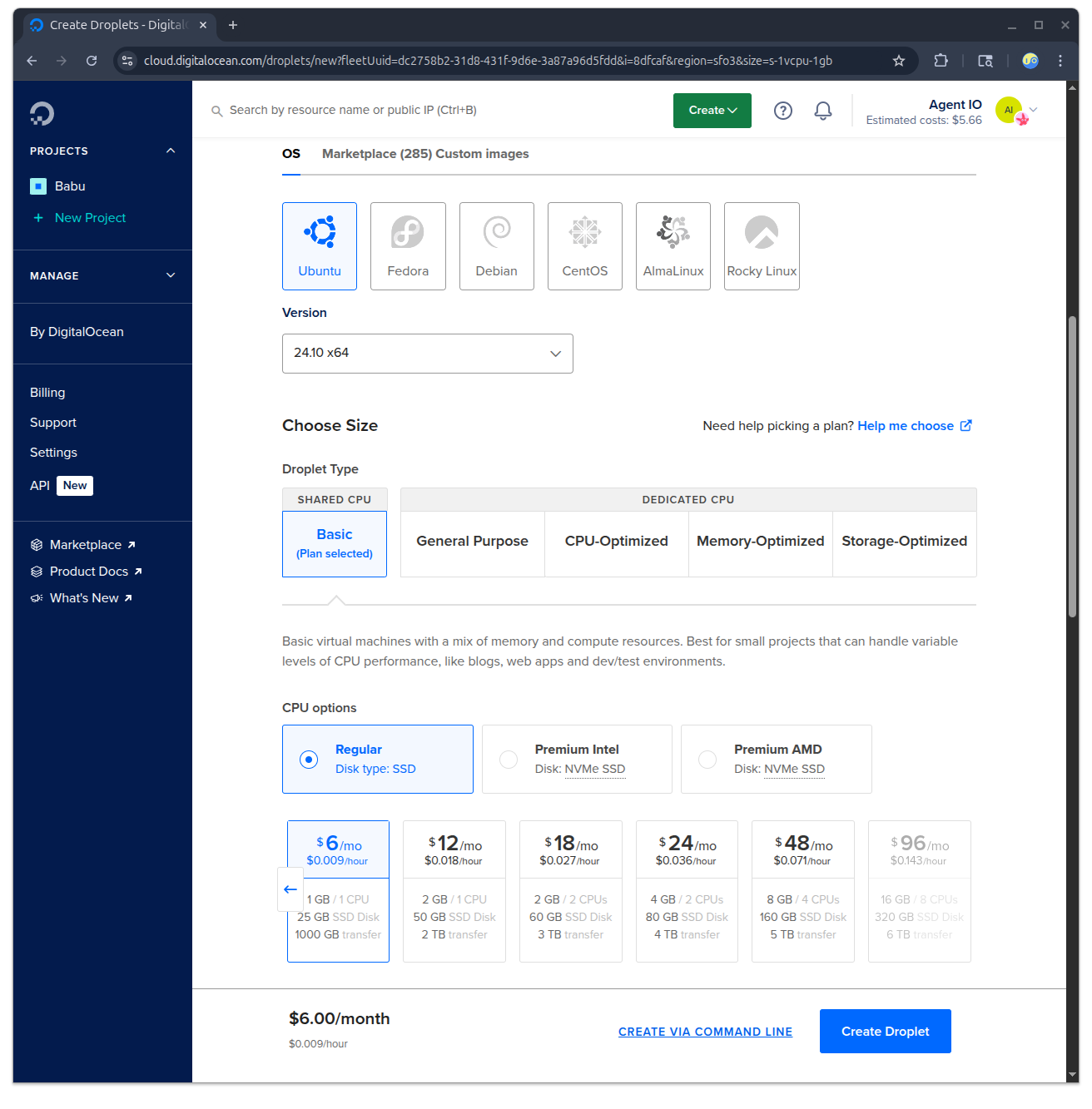
When you’re creating your droplet, add an SSH public key and take a minute to pick a custom name (the defaults are hard to remember). I’m picking names from the NATO phonetic alphabet; this one is “mike”.
Once your droplet is created, you’ll see an option to add a reserved IP address. There’s no cost for this, so it’s worth doing. With a reserved IP address, you can easily reassign your address to another droplet if you decide to change your backend instance.
Configure your domain#
You should have a domain that you can point at your droplet. Ideally, the DNS for your domain would be configured with two DNS “A” records. The first one (below) routes your root domain to your droplet, and the second routes all subdomains to your droplet.
Set these records to your reserved IP address.
A @ [YOUR-IP-ADDRESS]
A * [YOUR-IP-ADDRESS]
For these examples, I’m using the domain “noted.at”.
When your domain records have propagated, you should be able to connect to your droplet with SSH:
$ ssh noted.at -l root
Warning: Permanently added 'noted.at' (ED25519) to the list of known hosts.
Welcome to Ubuntu 24.10 (GNU/Linux 6.11.0-9-generic x86_64)
* Documentation: https://help.ubuntu.com
* Management: https://landscape.canonical.com
* Support: https://ubuntu.com/pro
System information as of Tue Jun 10 21:14:41 UTC 2025
System load: 0.01 Processes: 103
Usage of /: 7.8% of 23.10GB Users logged in: 0
Memory usage: 19% IPv4 address for eth0: 64.23.153.13
Swap usage: 0% IPv4 address for eth0: 10.48.0.7
180 updates can be applied immediately.
105 of these updates are standard security updates.
To see these additional updates run: apt list --upgradable
The programs included with the Ubuntu system are free software;
the exact distribution terms for each program are described in the
individual files in /usr/share/doc/*/copyright.
Ubuntu comes with ABSOLUTELY NO WARRANTY, to the extent permitted by
applicable law.
Create a firewall#
This is very important! IO creates a bunch of ports that your internal services will use. It also listens on three ports that should be open to the outside world (80, 443, and 8022).
You should configure your droplet firewall to ONLY allow access to these ports:
- 80 and 443 to allow HTTP and HTTPS access
- 8022 to allow remote SSH connections to your IO
- and 22 to allow remote SSH connections to your machine
Note that you could leave ports 22 and 8022 closed if you install a VPN like Tailscale in your droplet (but we won’t in this discussion).
Here’s the firewall configuration that I’m using:
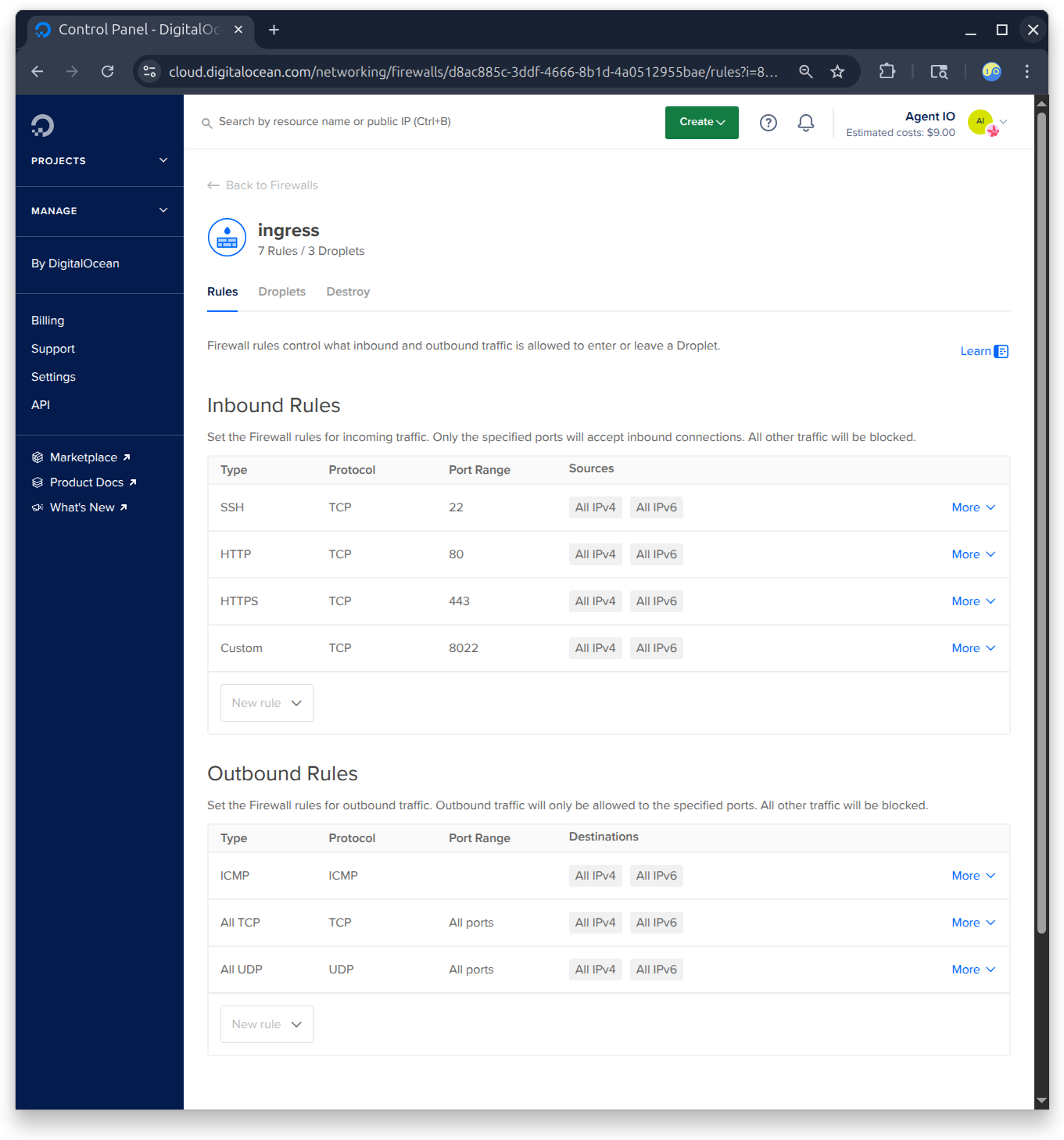
Install Docker#
First let’s install Docker. Use SSH to sign into your droplet and save this as DOCKER.sh:
#!/bin/sh
#
# This follows the instructions in Docker's "Install Docker Engine on Ubuntu"
# https://docs.docker.com/engine/install/ubuntu/#install-using-the-repository
#
# Add Docker's official GPG key:
sudo apt-get update
sudo apt-get install ca-certificates curl -y
sudo install -m 0755 -d /etc/apt/keyrings
sudo curl -fsSL https://download.docker.com/linux/ubuntu/gpg -o /etc/apt/keyrings/docker.asc
sudo chmod a+r /etc/apt/keyrings/docker.asc
# Add the repository to Apt sources:
echo \
"deb [arch=$(dpkg --print-architecture) signed-by=/etc/apt/keyrings/docker.asc] https://download.docker.com/linux/ubuntu \
$(. /etc/os-release && echo "${UBUNTU_CODENAME:-$VERSION_CODENAME}") stable" | \
sudo tee /etc/apt/sources.list.d/docker.list > /dev/null
sudo apt-get update
# Install Docker CE
sudo apt-get install docker-ce -y
Now run it:
$ sh DOCKER.sh
When it finishes, you can verify your docker installation with docker info. Here’s what I got:
root@mike:~# docker info
Client: Docker Engine - Community
Version: 28.2.2
Context: default
Debug Mode: false
Plugins:
buildx: Docker Buildx (Docker Inc.)
Version: v0.24.0
Path: /usr/libexec/docker/cli-plugins/docker-buildx
compose: Docker Compose (Docker Inc.)
Version: v2.36.2
Path: /usr/libexec/docker/cli-plugins/docker-compose
Server:
Containers: 0
Running: 0
Paused: 0
Stopped: 0
Images: 0
Server Version: 28.2.2
Storage Driver: overlay2
Backing Filesystem: extfs
Supports d_type: true
Using metacopy: false
Native Overlay Diff: true
userxattr: false
Logging Driver: json-file
Cgroup Driver: systemd
Cgroup Version: 2
Plugins:
Volume: local
Network: bridge host ipvlan macvlan null overlay
Log: awslogs fluentd gcplogs gelf journald json-file local splunk syslog
CDI spec directories:
/etc/cdi
/var/run/cdi
Swarm: inactive
Runtimes: io.containerd.runc.v2 runc
Default Runtime: runc
Init Binary: docker-init
containerd version: 05044ec0a9a75232cad458027ca83437aae3f4da
runc version: v1.2.5-0-g59923ef
init version: de40ad0
Security Options:
apparmor
seccomp
Profile: builtin
cgroupns
Kernel Version: 6.11.0-9-generic
Operating System: Ubuntu 24.10
OSType: linux
Architecture: x86_64
CPUs: 1
Total Memory: 961MiB
Name: mike
ID: a0f33553-d74f-40d8-892d-da52fab2e0c6
Docker Root Dir: /var/lib/docker
Debug Mode: false
Experimental: false
Insecure Registries:
::1/128
127.0.0.0/8
Live Restore Enabled: false
Install Nomad#
Now let’s install Nomad. Save the following to a file named NOMAD.sh:
#!/bin/sh
#
# This follows the instructions in Hashicorp's "Install Nomad"
# https://developer.hashicorp.com/nomad/docs/install
#
# Install required packages.
sudo apt-get update && \
sudo apt-get install wget gpg coreutils -y
# Add the Hashicorp GPG key.
wget -O- https://apt.releases.hashicorp.com/gpg | \
sudo gpg --dearmor -o /usr/share/keyrings/hashicorp-archive-keyring.gpg
# Add the official HashiCorp Linux repository.
echo "deb [signed-by=/usr/share/keyrings/hashicorp-archive-keyring.gpg] https://apt.releases.hashicorp.com $(lsb_release -cs) main" \
| sudo tee /etc/apt/sources.list.d/hashicorp.list
# Update and install Nomad.
sudo apt-get update && sudo apt-get install nomad -y
Now run it:
$ sh NOMAD.sh
When that finishes, you can confirm that nomad was installed by running nomad with no arguments:
root@mike:~# nomad
Usage: nomad [-version] [-help] [-autocomplete-(un)install] <command> [args]
Common commands:
run Run a new job or update an existing job
stop Stop a running job
status Display the status output for a resource
alloc Interact with allocations
job Interact with jobs
node Interact with nodes
agent Runs a Nomad agent
Other commands:
acl Interact with ACL policies and tokens
action Run a pre-defined command from a given context
agent-info Display status information about the local agent
config Interact with configurations
deployment Interact with deployments
eval Interact with evaluations
exec Execute commands in task
fmt Rewrites Nomad config and job files to canonical format
license Interact with Nomad Enterprise License
login Login to Nomad using an auth method
monitor Stream logs from a Nomad agent
namespace Interact with namespaces
operator Provides cluster-level tools for Nomad operators
plugin Inspect plugins
quota Interact with quotas
recommendation Interact with the Nomad recommendation endpoint
scaling Interact with the Nomad scaling endpoint
sentinel Interact with Sentinel policies
server Interact with servers
service Interact with registered services
setup Interact with setup helpers
start Start a stopped job
system Interact with the system API
tls Generate Self Signed TLS Certificates for Nomad
ui Open the Nomad Web UI
var Interact with variables
version Prints the Nomad version
volume Interact with volumes
Configure Nomad#
We need to configure Nomad before we start it. We’re going to configure a very simple cluster: just one node that’s both a Nomad client and server (you can look up those definitions later).
Replace the /etc/nomad.d/nomad.hcl in your droplet with this:
data_dir = "/opt/nomad/data"
bind_addr = "0.0.0.0"
server {
enabled = true
bootstrap_expect = 1
heartbeat_grace = "1m"
}
client {
enabled = true
servers = ["127.0.0.1"]
host_volume "io" {
path = "/srv/nomad/io"
read_only = false
}
}
This configuration creates some storage for IO in what Nomad calls a “host volume”. For this to work, you’ll need to also create this directory on your droplet.
mkdir -p /srv/nomad/io
Start Nomad#
Now you can start Nomad. Do that by running the systemctl enable subcommand on your droplet, which will cause Nomad to restart whenever your droplet reboots. Here we add the --now option to also start Nomad now.
systemctl enable --now nomad
If that worked, you can now run nomad agent-info to get details about your running cluster.
Run IO with Nomad#
Our next step is to set up an an IO that will manage this droplet’s HTTP and HTTPS connections.
We’re going to run this IO with Nomad.
Before starting it, you’ll need to have an io.db in /srv/nomad/io that is initialized with your license key and SSH users. You can create the io.db by running IO locally. Here license.hcl contains your license key and users.hcl contains the user configuration (see Add an SSH key to allow remote login for an example of users.hcl).
# Do this on your local system!
IO.sh -c license.hcl -c users.hcl -x
When that’s done, copy your io.db to the /srv/nomad/io directory on your droplet
$ scp io.db root@noted.at:/srv/nomad/io
io.db
Now we need to tell Nomad to run IO. We do that with a Nomad job description that is also represented in HCL (both IO and Nomad use HCL for configuration).
Here’s the Nomad job description that we need to run IO. Save it in a file named io.hcl and copy it to your droplet.
job "io" {
datacenters = ["dc1"]
type = "service"
group "io" {
count = 1
service {
name = "io"
provider = "nomad"
}
volume "io" {
type = "host"
read_only = false
source = "io"
}
task "io" {
driver = "docker"
config {
image = "agentio/io:latest"
network_mode = "host"
force_pull = true
}
volume_mount {
volume = "io"
destination = "/io"
read_only = false
}
}
}
}
Now, on your droplet, use nomad job run to start your job.
root@mike:~# nomad job run io.hcl
==> View this job in the Web UI: http://127.0.0.1:4646/ui/jobs/io@default
==> 2025-06-10T22:04:03Z: Monitoring evaluation "e98343ac"
2025-06-10T22:04:03Z: Evaluation triggered by job "io"
2025-06-10T22:04:03Z: Allocation "222aa15d" created: node "5892cb5c", group "io"
2025-06-10T22:04:04Z: Evaluation within deployment: "282f379d"
2025-06-10T22:04:04Z: Evaluation status changed: "pending" -> "complete"
==> 2025-06-10T22:04:04Z: Evaluation "e98343ac" finished with status "complete"
==> 2025-06-10T22:04:04Z: Monitoring deployment "282f379d"
✓ Deployment "282f379d" successful
2025-06-10T22:04:22Z
ID = 282f379d
Job ID = io
Job Version = 0
Status = successful
Description = Deployment completed successfully
Deployed
Task Group Desired Placed Healthy Unhealthy Progress Deadline
io 1 1 1 0 2025-06-10T22:14:21Z
root@mike:~#
If all goes well, you’ll be able to see your IO running in Docker.
root@mike:~# docker ps
CONTAINER ID IMAGE COMMAND CREATED STATUS PORTS NAMES
18afc1bcd498 agentio/io:latest "/usr/local/bin/io io" 49 seconds ago Up 49 seconds io-222aa15d-da7d-339f-f49d-63babe2cf7b9
Connect to IO#
With an IO up and running on your droplet, you should now be able to connect remotely to it. Try this on your local machine (one where your SSH private key is installed):
ssh -p 8022 noted.at
If all goes well, you’ll see the IO console:
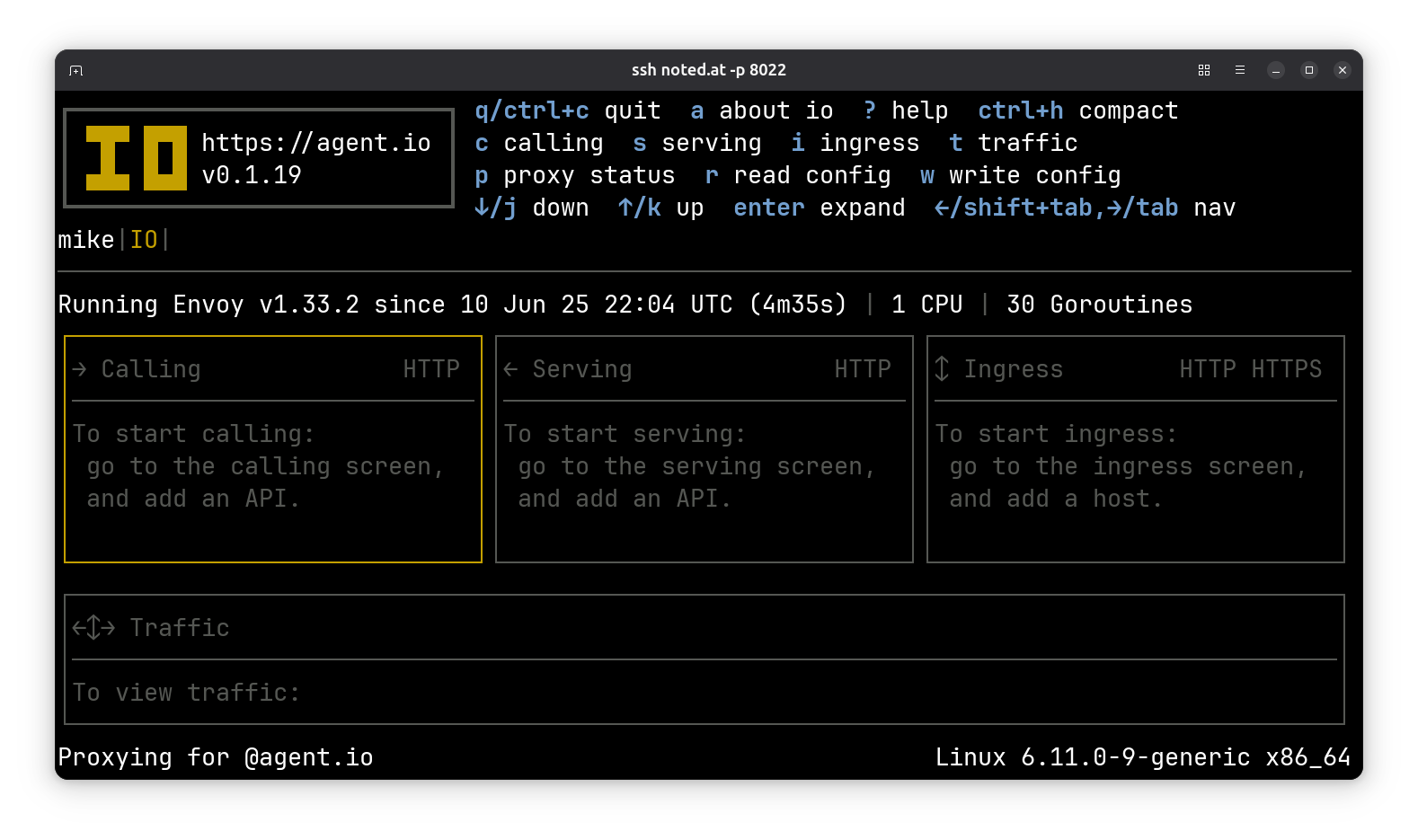
Create your first ingress#
Now for fun, let’s set up a service on your droplet and give it an IO ingress. From the IO home screen, press i to go to the ingress screen and press n to create a new ingress. Set the host to your droplet’s domain. The name can be any user-friendly name, and the backend should be internal:httpbin. This tells your ingress to serve a version of HTTPBin that is built into IO for testing.
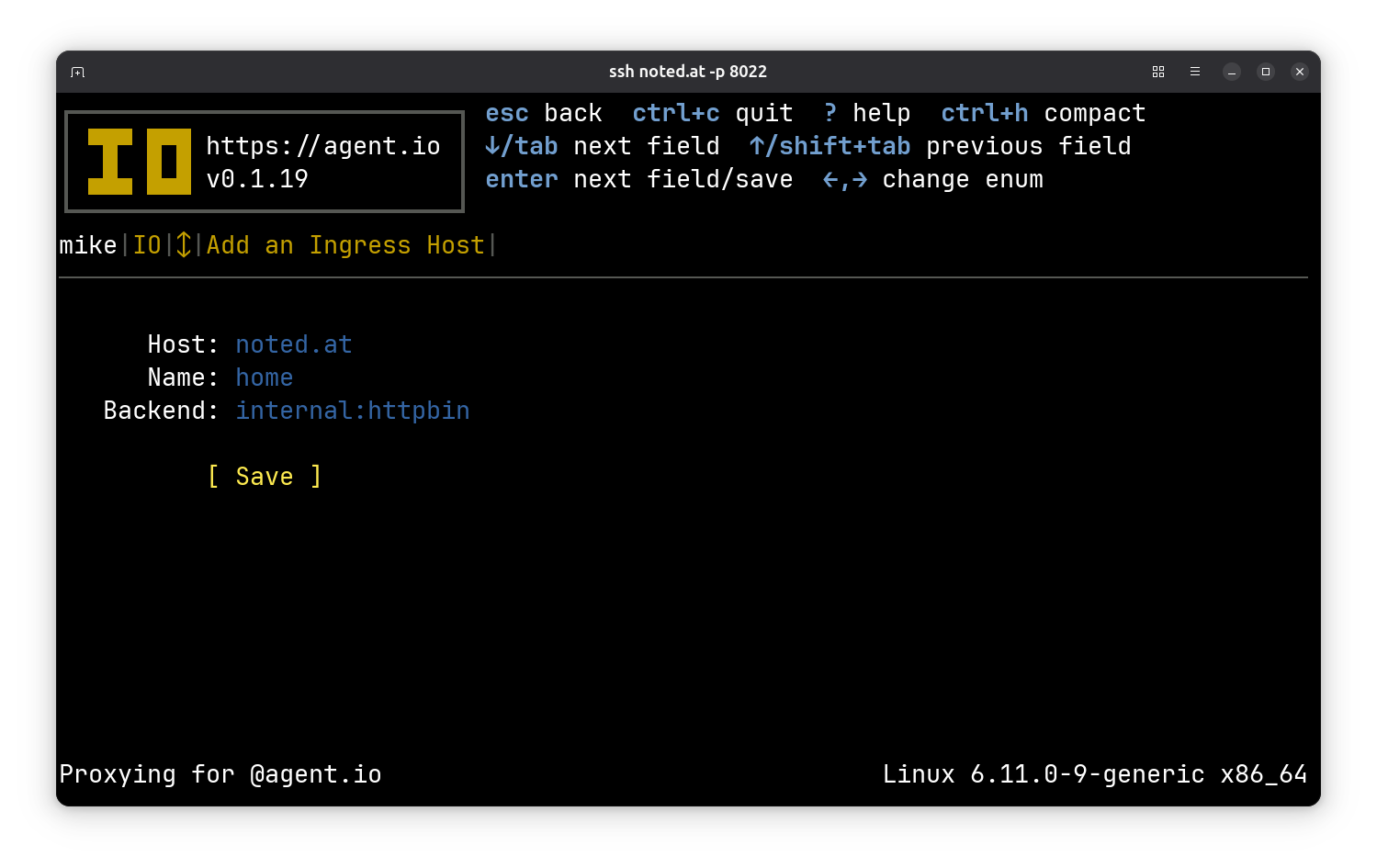
When that’s saved, you should see a view of your ingress like this:

We need an SSL certificate for this ingress. Before we can request one, we need to set a contact email address for LetsEncrypt. Go up a level (press ESC) to the ingress overview screen and press e to edit your general ingress configuration. Tab down to the LetsEncrypt User field and enter your email address. Press tab again and then enter to save this.
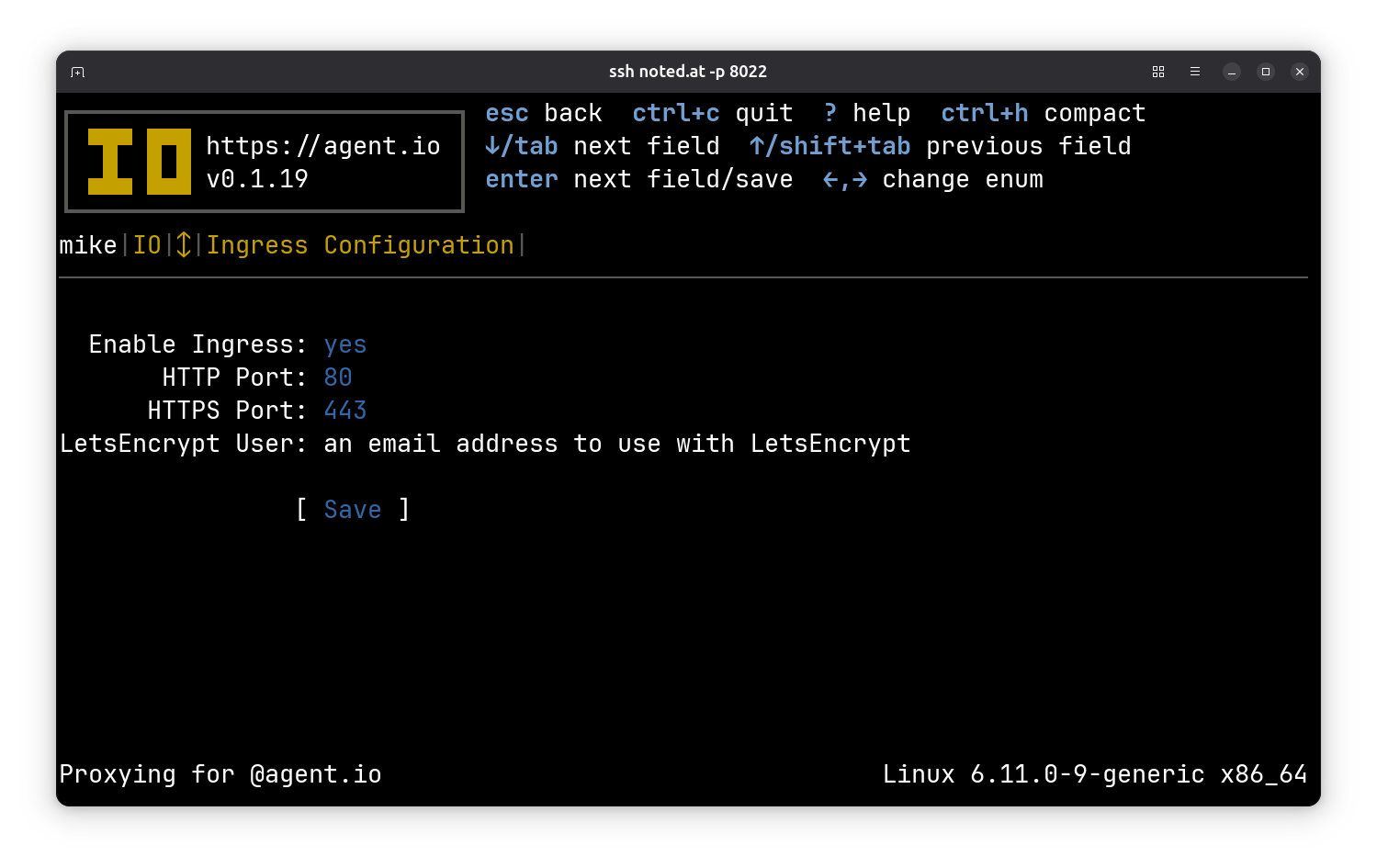
Now go back to the detail view of your new ingress and press f to “fetch” a certificate from LetsEncrypt. You’ll see challenge requests appearing in the traffic screen.
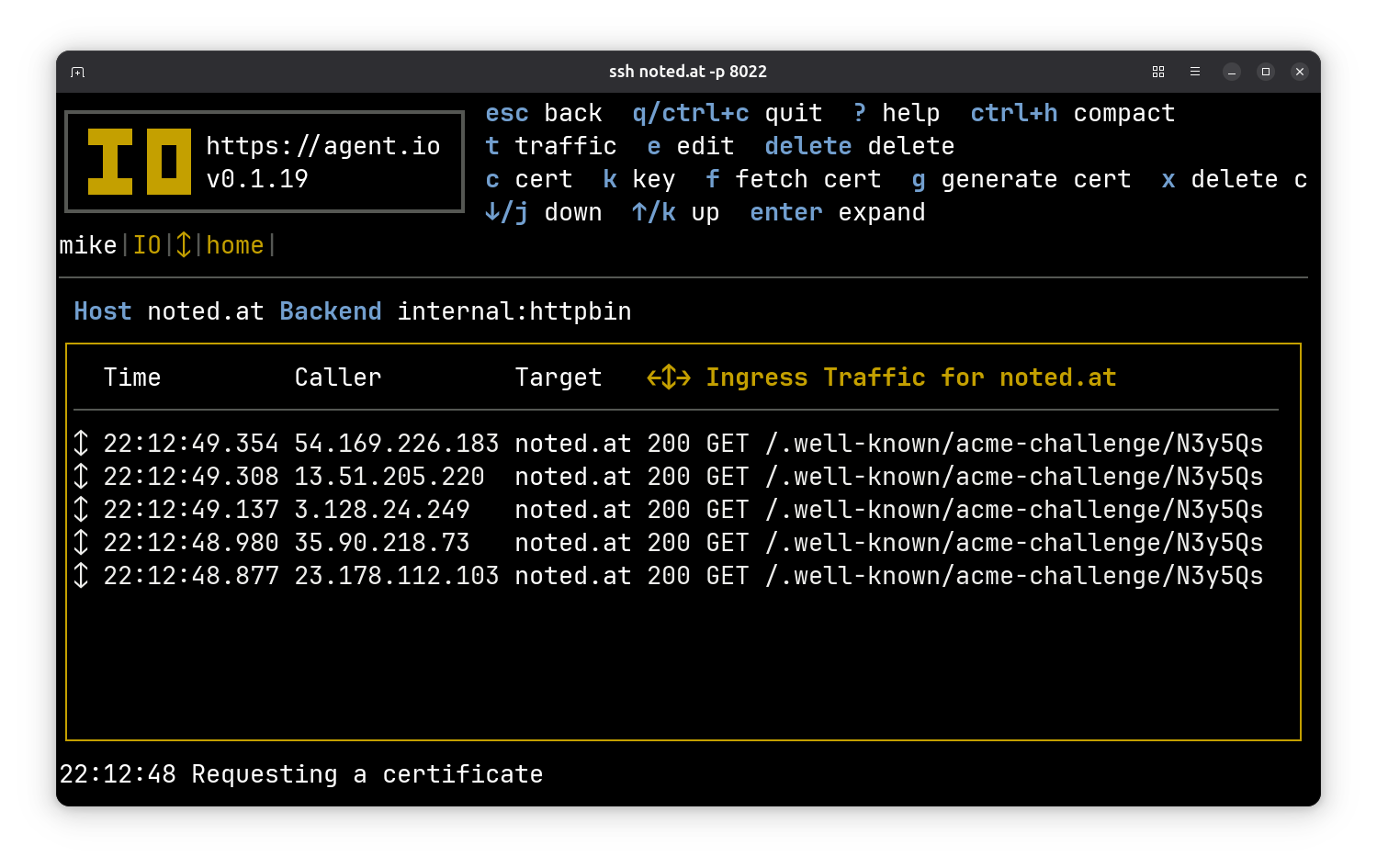
After a minute or so, you’ll see a message at the bottom confirming that your certificate was generated.
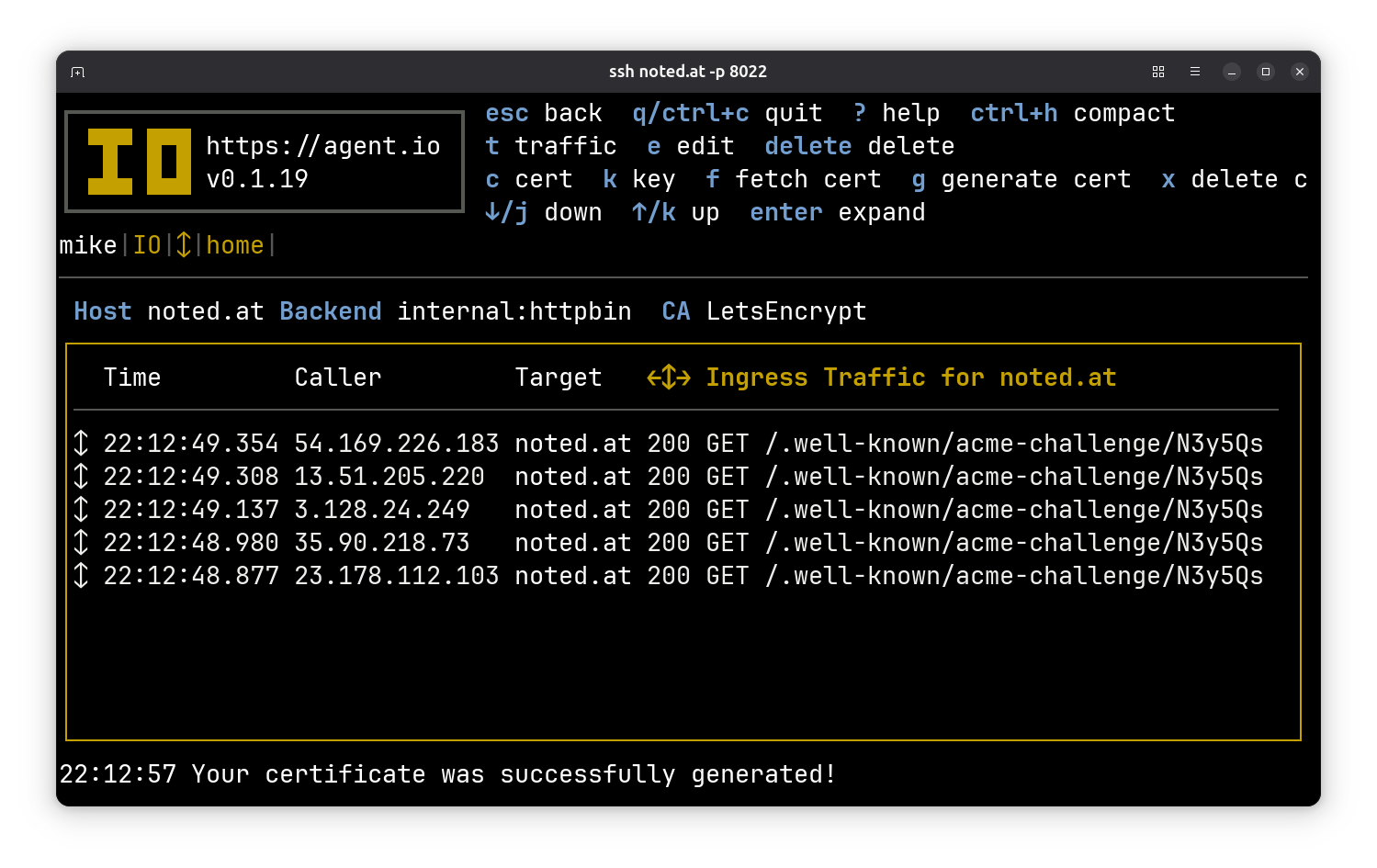
Now grab your web browser and visit your droplet domain. You should get the go-httpbin main screen.
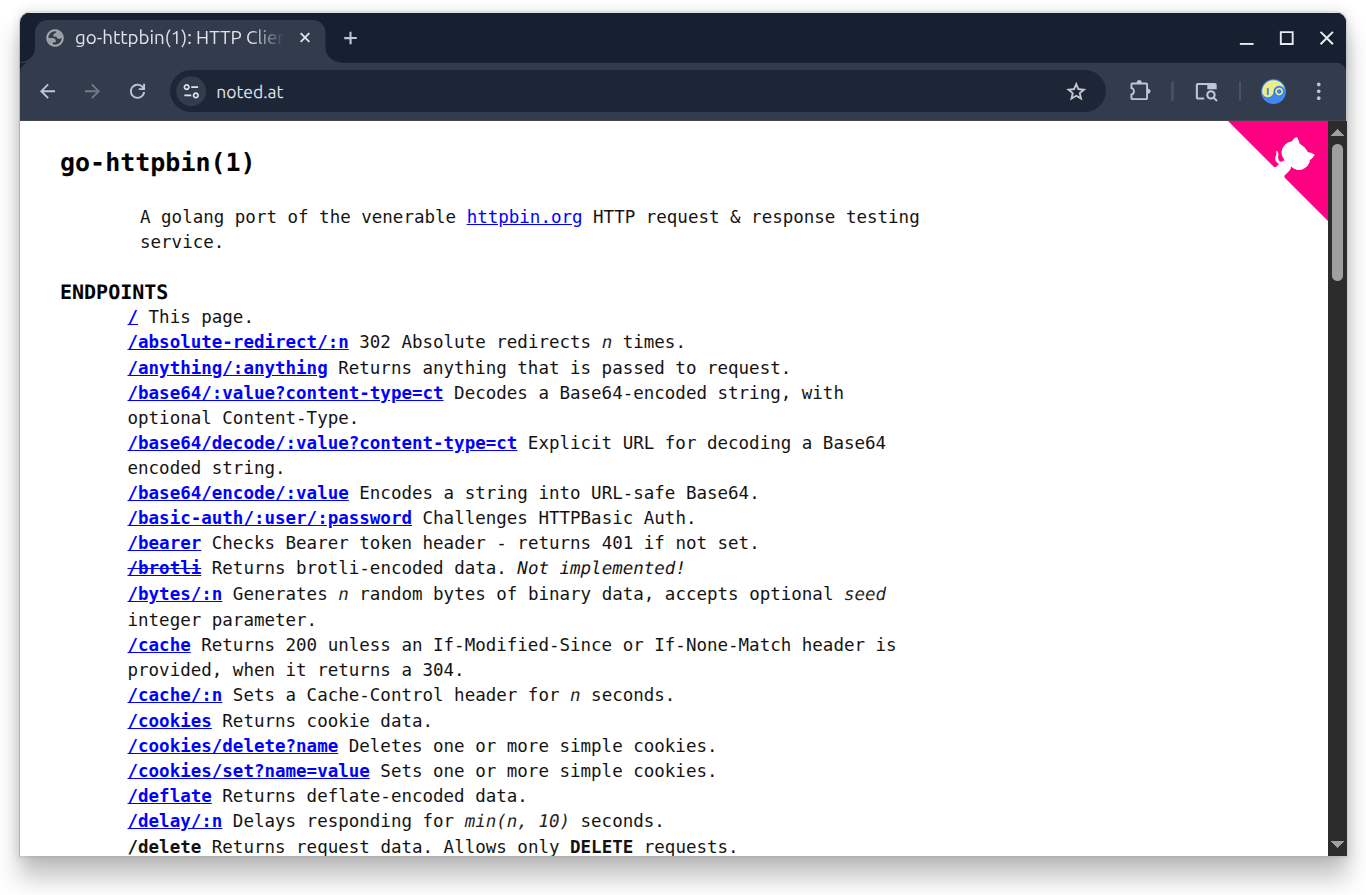
Congratulations! You now have droplet-publishing superpowers!
Securely connect to your Nomad console with IO#
For one more trick, we’re going to use IO to set up a secure ingress to your Nomad console. Here’s the IO configuration:
serve "nomad" {
name = "Nomad"
port = 9009
backend = "127.0.0.1:4646"
require_atproto {
handles = ["timburks.me"]
}
}
host "nomad.noted.at" {
name = "Nomad"
backend = "serving:nomad"
atproto {
name = "Nomad"
scopes = ["atproto"]
}
}
The first block declares a serving interface that points to your droplet’s Nomad console and republishes it on port 9009. It also adds an authorization requirement: only AT Protocol users with handles in this handles list will be allowed to connect. Change this to include your handle (and take mine out of it!).
The next block declares an ingress for the specified host. Here you should replace nomad.noted.at with some subdomain of your droplet’s domain. This ingress includes a block that tells IO to handle AT Protocol signin for this host. The name field will be used in the client id. We only need the atproto scope because we are just asking for a user’s identity.
Save the modified version of this file on your local system (yes, really) as nomad.hcl and then copy it to your IO with SCP.
$ scp -P 8022 nomad.hcl noted.at:
nomad.hcl 100% 273 14.1KB/s 00:00
(Cool, huh? You just uploaded a new configuration using SCP.)
Go back to the IO console and get an SSL certificate for your new host.
After that, when you try to connect to your new subdomain, you’ll be redirected to an AT Protocol signin screen.
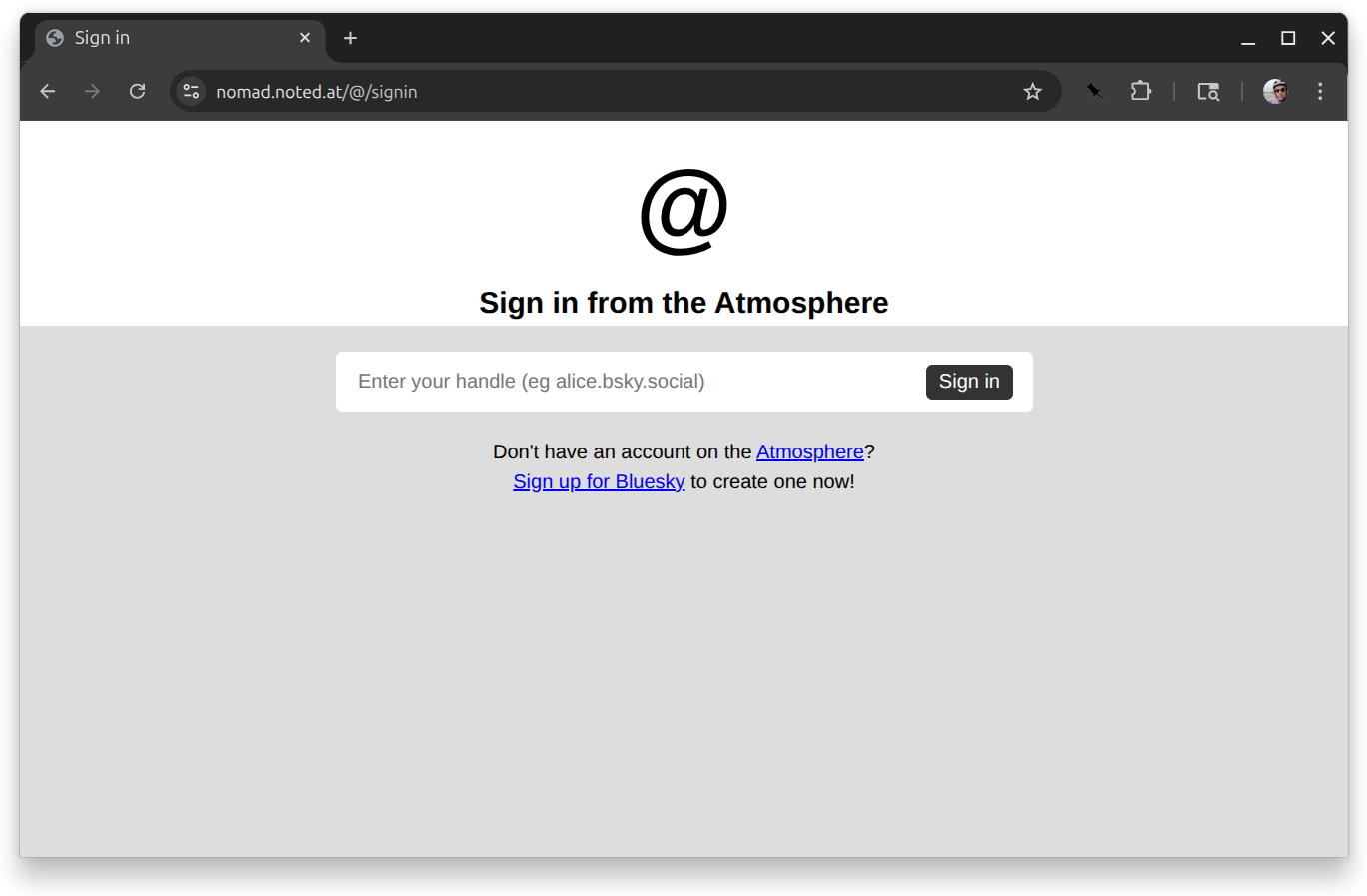
When you type in your handle and press enter, you’ll be redirected to your PDS to sign in.
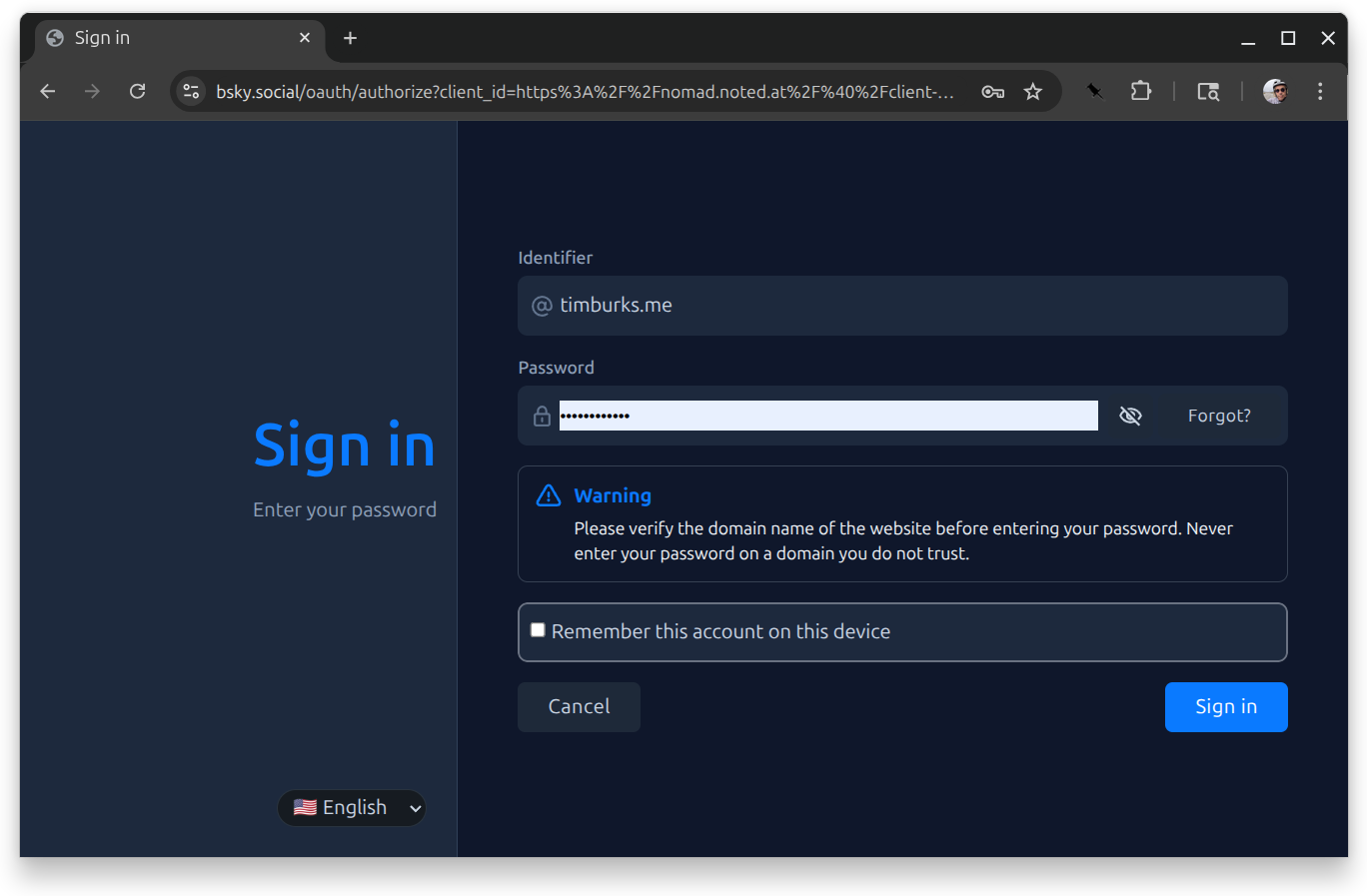
From there you’ll go to an authorization screen.

If you approve that, you’ll be redirected back to your backend, which now is your droplet’s Nomad console.
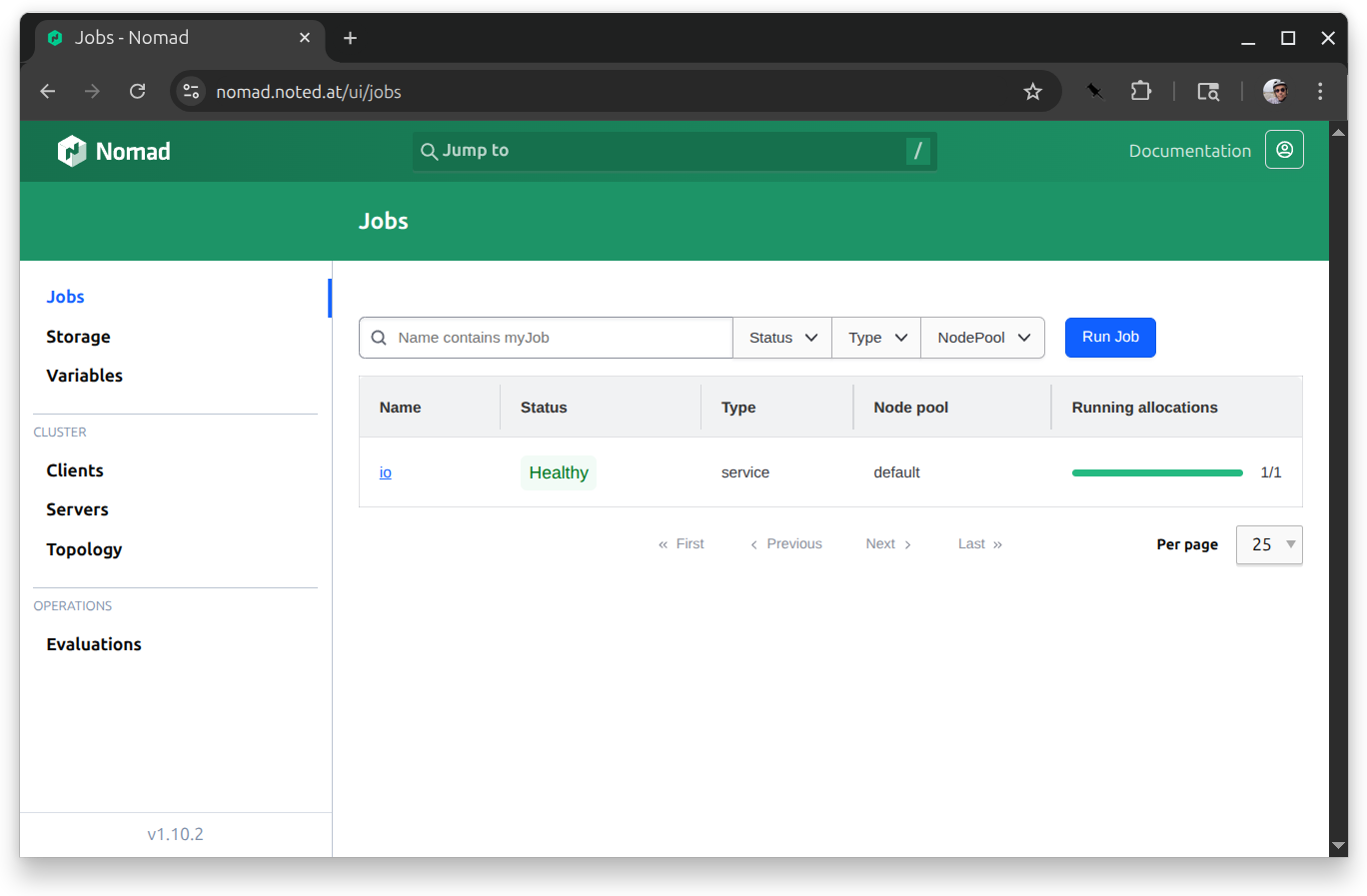
To sign out, just visit the /@/signout path of your console host. This and other special AT Protocol authorization features will be the topic of a future post!
